Harley-Davidson LiveWire Review
Motorcycle Test by Wayne Vickers – Images by Colin Rosewarne
Apparently, some stories just write themselves. On this one, I set out to give LiveWire a real world test, with the goal being to address what I see as the two biggest concerns that most riders have about electric bikes. Namely: range anxiety and the worry about what might happen if you get caught short and end up with a flat battery. As it turns out, I ticked those off on day one…we’ll get back to that in a bit.
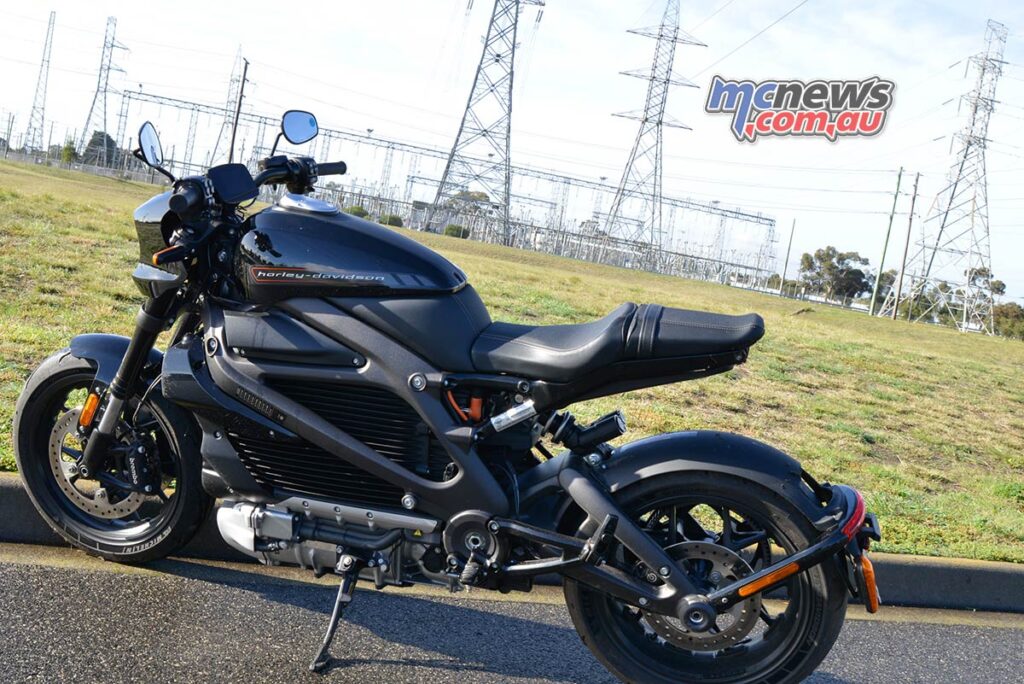
The Harley-Davidson LiveWire. Bit of a head scratcher really. Bought to you by the company that’s synonymous with a loud, bad boy image, it stood out on the showroom floor like a.. Well, like a silent, squarish looking matt black, grey and alloy electric bike amongst a bunch of chromed up cruisers. Of all the mainstream manufacturers, I don’t think anyone thought that Harley would be one of the first to market with an EV motorcycle. The marketing department must be going nuts trying to figure out how to fit this very square peg into the brand matrix… (actually turns out that the LiveWire brand is set to be separated from Harley – so that answers that).
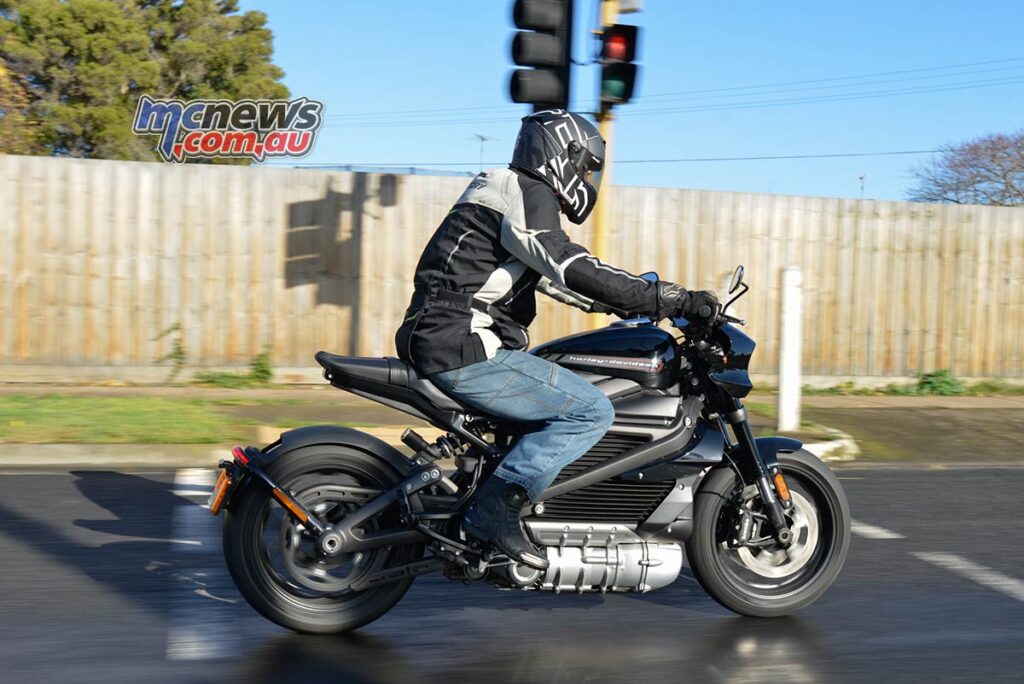
If you haven’t read or heard about it, here it is in a nutshell: Harley’s first electric bike. That motor puts out 105 hp and 116 Nm and as we have all heard plenty of times about electric motors, all of that torque is available right off the bottom. Range is claimed to be 235 kilometres for urban usage with a minimum claimed range of 158 kilometres. It packs serious Showa suspension at both ends and Brembo monoblocs up front – and even though it’s pushing 250 odd kilos, it’ll silently chalk up 100 km/h in close enough to three-seconds dead. So it’s certainly fast enough… Full charge takes around 11-hours on a standard 240v plug, but apparently will get to 80 per cent in 40-minutes on a fast charging station.
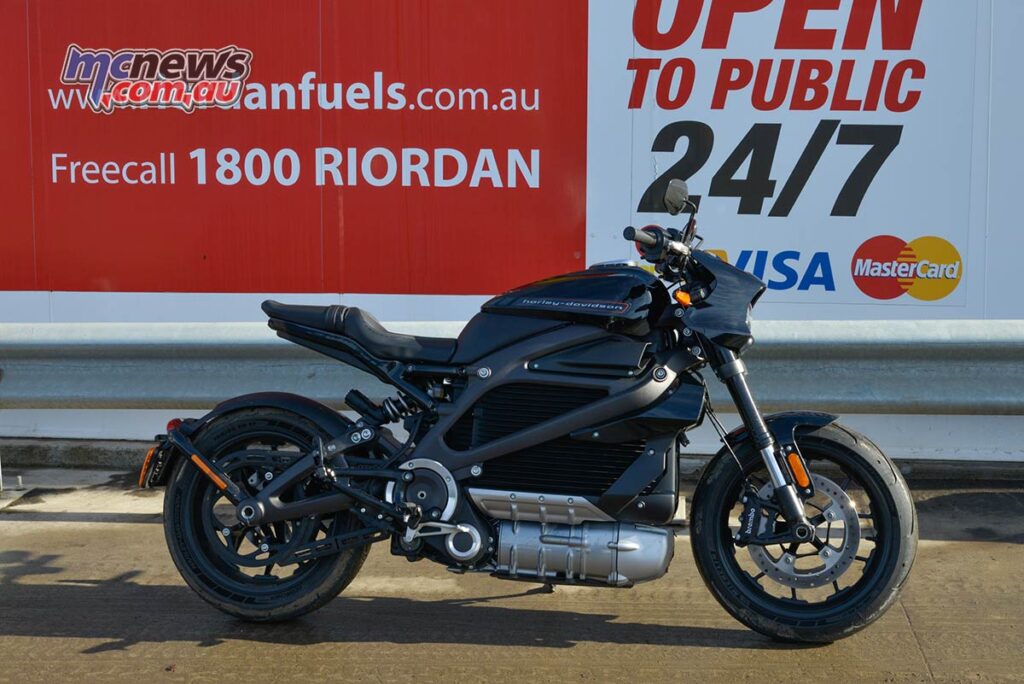
After a quick walk around of the bike in the showroom, taking me through the basics including the startup process and ride modes I was let loose to tear up the streets. Quietly.
Setting off with close enough to full charge (97 per cent to be exact), I was told that I was likely to get 130 kilometres on the open road or 170 kilometres of urban riding, which is notably less than the claimed range incidentally… Worth noting that the range is higher for urban riding than highway use. It’s the opposite to combustion engines as the electric bike uses regenerative braking to recharge the battery on the go, which is more active around town. So with that knowIedge in mind, I set off on the 110 kilometre journey home.
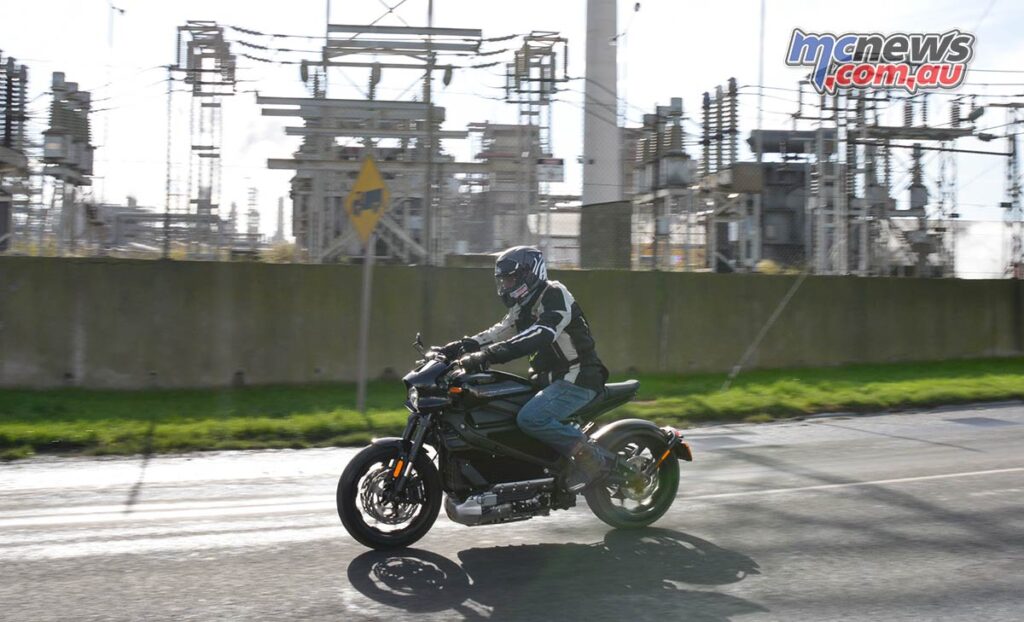
Turns out, it rides fairly well. The riding position is described by Harley as sporty. And maybe compared to other bikes in their line-up it might be, but for non-harley riders… it’s really not… it’s actually perfectly comfortable and upright. Of the four modes (road, sport, rain and eco), I left it pretty much in Road mode. Other than a couple of minutes in sport mode to see if it felt much different I figured I’d get used to what most riders would probably run for the most part. The difference between road and sport was noticeable but not dramatic, with Sport having a slightly sharper throttle response and a decent step up in the regenerative braking effect, meaning less need for using the actual brakes. So much so that the bike flicks the brake light on when decelerating under regen. That’s clever.
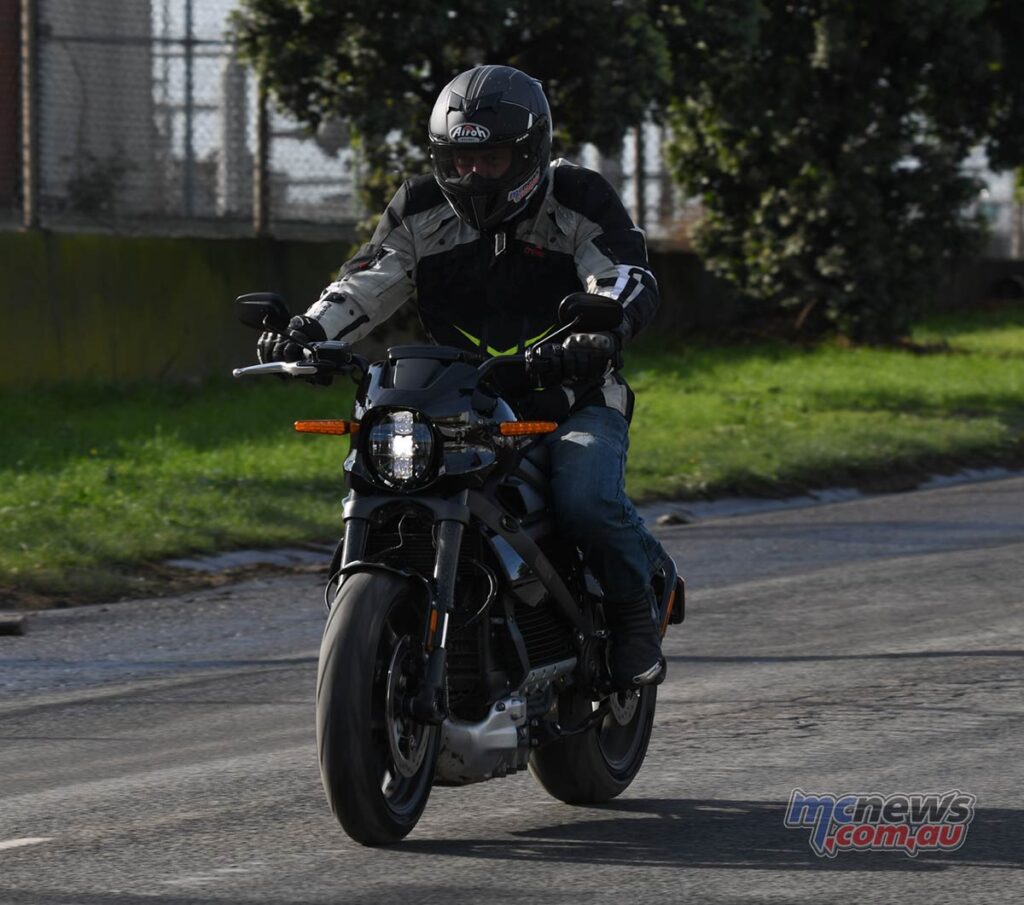
Around town it’s fairly pleasant. Very easy to ride. Tips in ok, rides not at all unlike a conventional bike. And there’s no denying that straight line performance is very solid. Probably more described as ‘deceptive’ than any other word I can think of right now. Because there are no dips in power, or gears to snick through, acceleration is ludicrously linear. The power curve isn’t a curve at all. It’s a line. That translates to acceleration on tap, whenever you want it. But it’s not brutal or harsh or any of that. The throttle is beautifully soft and direct. Yes, it’s weird not to have a soundtrack, I personally think it does take away part of the experience – and I was more wary of that amongst traffic as I normally rely on a bit of exhaust note to help inform drivers that I’m there. So you’d just have to keep that in mind and ride even more defensively.
Another little aside – the traction control really doesn’t work on wet grass…as in, at all. As I found out while positioning it for some pics, once traction was lost (unintentionally fwiw) it very quickly accelerated the rear beyond where I expected it to and it threw mud positively bloody everywhere. You can probably see the aftermath of that in some of the pics. Which then got me wondering if the traction control worked from standstill at all… Ummm, not really is the answer. A little impromptu burnout got very smokey, very quickly. Now I’m not normally a burnout kinda guy, but it turns out that electric motors are really, really, stupidly good at burnouts. So that’s a thing. Makes sense when you think about it. No gears to worry about, just twist, smoke and giggle. Tyre bill might get a bit expensive though.
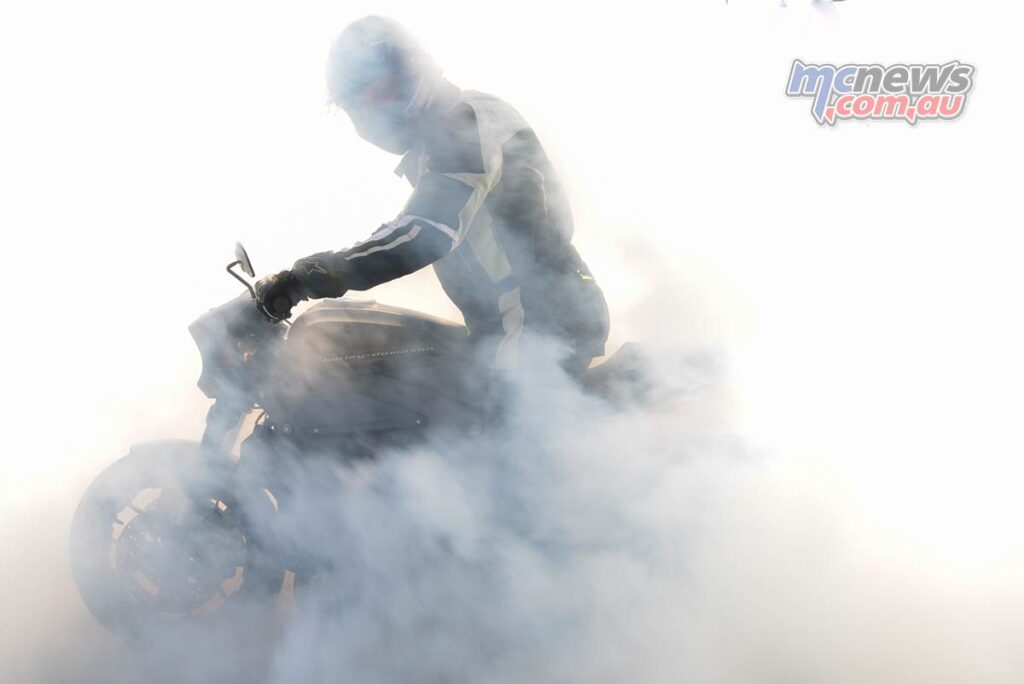
Suspension, chassis and brakes are all ok. Steering is fairly slow and heavy and the suspension seemed overly firm as well – borderline harsh. And while there wasn’t anything specific I can point to – as a whole it didn’t really seem to come together for me. Bumps and surface changes are all felt more than they should be. The more I rode it the more it seemed at odds with what the bike is and is not. It’s not a sports bike. Doesn’t handle like one, nor have the range to make it to your favourite twisties and back… but more on that in a bit. So I dunno why it needs to be that firm.
The other call out worth mentioning here is that I felt it was a little resistant to tip in past say… 30 degrees? Not really noticeable around town, but when you actually wanted to get up it, it didn’t feel in its element. To the point where it felt like instead of being comfortable on its side, it was often wanting to sit up even on a constant throttle. I wonder if that’s something to do with gyroscopic forces of the electric motor spinning away? Not sure. But it didn’t feel like a natural corner carver.
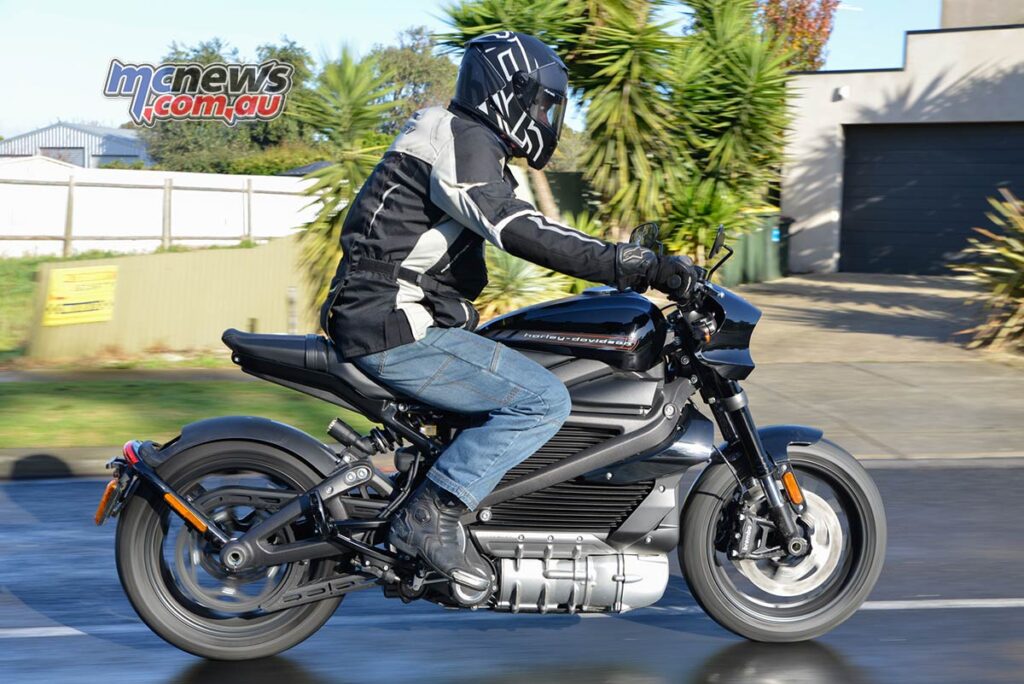
One little ‘not so clever’ design element I came across was the indicator switches. Minor I know. While the left indicator is in the standard position on the left cluster the right indicator is on the right cluster… so you often have to adjust the position of your throttle hand in order to put the right hand indicator on. And almost every time I used the indicator I found it impacting the throttle. Considering this bike has no clutch, so your left hand is doing nothing most of the time anyway, I don’t understand why you’d do this. Keep your throttle hand free to focus on the throttle please.
I was told at the dealer to keep an eye on the speed on the dash, as it can be easy to lose track of what speed you’re doing. I didn’t find it to be much of an issue in traffic, but certainly without a prominent engine noise to subconsciously use as a reference, there was a couple of times I crept past what I thought I was doing out on the highway. Cruise control took care of that while I got used to it.
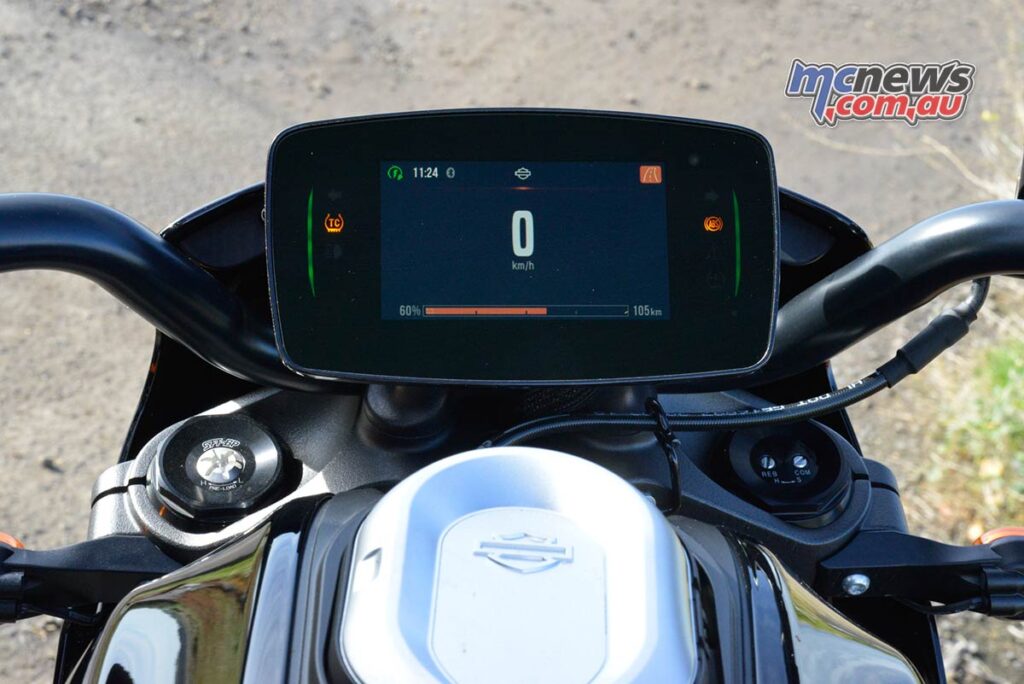
Another thing to note – I found the charger and key fob, both stored under the seat would rattle a bit on bumps and corrugations (which were felt pretty badly). I’d throw a cloth or something in there to stop it from moving about, but it probably should have some foam or something from the factory.
Once out of town, I noticed at about the half way to home mark that the projected range had dropped from 170 kilometres to about 90. No drama, only about 60 km to go, should be fine Wayno. It’s supposed to get 130…
Then once the battery dipped below the 25 per cent mark the expected range started taking a nose dive and doubt started creeping in. It was at about the 30 km from home mark, well after I’d passed the last quick charging point in Geelong, that I started to sweat on the range. I buttoned right off. Back to 80 km/h. It seemed to help. For a bit. Then I backed off further.
Shit.
I’m not going to make it.
Roughly six kilometres out from home I hit zero charge on the dash. But it kept going. A glimmer of hope! They’ve engineered a bit of extra into this like a reserve I thought. But that joy was short lived. About four kilometres to go it started cutting power even below the 40 km/h I was then sitting on. Low battery warnings had been flashing on the dash for a while now, but they were joined by a little turtle icon. I was officially in limp mode. At eight kilometres per hour. Wonder how long that’ll get me?
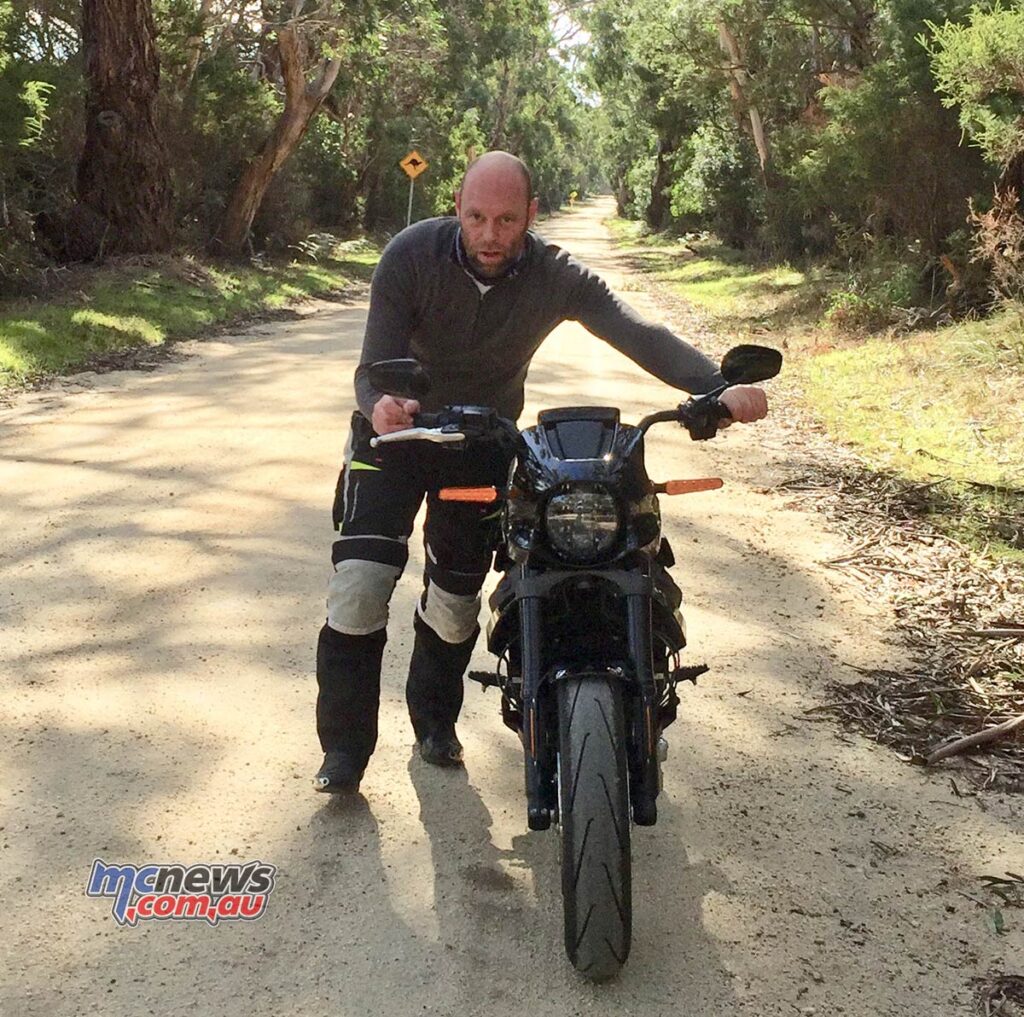
Turns out only about another kilometre. Then I was off the bike pushing with the slightest smidgen of assistance. Incidentally, it turns out my ‘pushing a motorbike speed’ is five kilometres per hour. I was within three kilometres of home. Then the hill came. I just wanted to get to the top of the hill. I think I can I think I ca.. And then everything shut down.
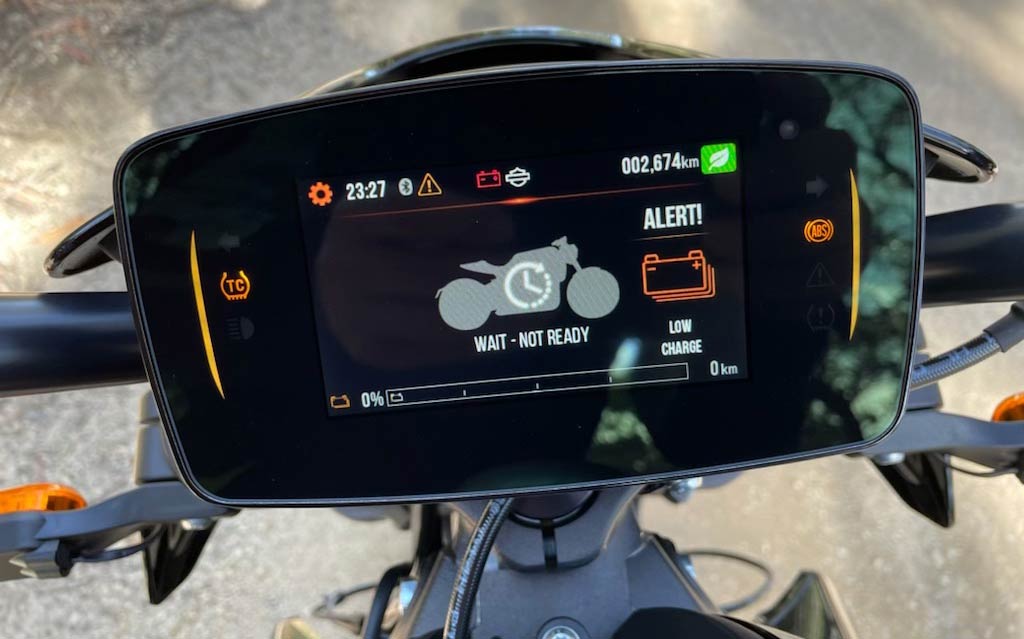
Various colourful words were used.
I was proper cooked. That last two-and-a-half-kays pushing 250 kegs took a while. My wife was lovely enough to come down and help with the last kilometre. After she laughed and took some pics of my sweaty, red melon.
So, no. It won’t get you the claimed minimum distance. I got just under 108 kilometres on 97 per cent charge.
But that was only the start of the fun.
Once home, I pulled out the charger, plugged it in, whacked it in the top of the ‘tank’, to beginning the recharge. Giddy up. Or so I thought. I went back an hour later to check and it showed no change with the dash still blank.
Bugger.
Help me Google-wan-kenobi, you’re my only hope. Google dutifully informed me that the little light on the charger was supposed be pulsing when it’s charging. Mine was lit up solid. Hmm.. Further googling told me that there’s a secondary 12v battery that runs the low voltage electrics and manages the cooling system while the ‘main’ battery charges. And if that 12v one goes flat, the whole thing won’t accept charge.
Eh?
So a fully flat battery will leave you stranded and unable to charge via the normal plug. Who signed off on that as an acceptable system design?
Phone calls to the dealer – who were terrific for what it’s worth – confirmed that the secondary 12v battery would be the issue. It would require a lithium specific charger to be plugged into the secondary battery. But even that might not work as it might have gone into a safety shutdown mode. Running it fully flat might have even cooked the battery altogether… Brilliant.
The battery itself was easy enough to locate and get onto a charger. But no, it wasn’t playing along. Ergh. The workshop boys mentioned that they’d try to jimmy another battery onto it to trick it into accepting charge. So I got to work with my best bush mechanic skills. Paralleled another spare 12v battery I had in the shed and the dash came on! And then went off. Not enough juice.
So I charged up that spare (third) battery and put it back on as parallel and tried again. Still no joy. The dash would light up, but it wasn’t tripping the cooling system on, which it needed to do, to allow the main battery to charge. ‘I wonder what would happen if I put the charger on that third parallel battery while it’s all connected up’ says I, slightly concerned about the fact that lithium batteries can do funny things like trip into runaway heat cycles, catch on fire and burn a hole in your concrete floor. Oh well. In for a penny, in for a pound. Let’s give it a go. Hooked it all up, which looked like the nastiest hodge podge you’ve ever seen, and lo and behold.. The cooling system finally kicked into gear after a few minutes of false starts and a few jiggles of the main plug and toggling of switches.
We were in business. It was charging. I had a battery charger connected to a spare 12v battery, connected to the onboard 12v battery so that the low power system could run the cooling – which would then allow the main charger to charge the main battery. Simples!
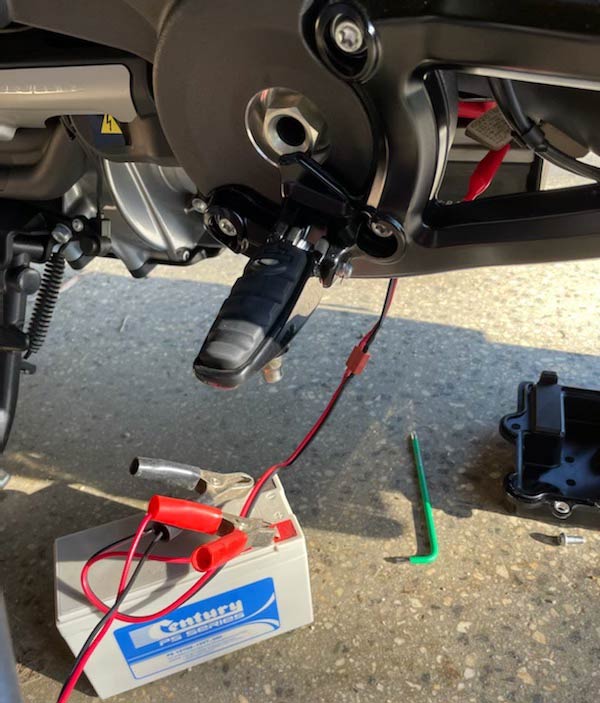
What a nightmare.
The lesson here would be – either don’t let it run fully flat if you have one… or – if you’re trying to replace a system where, when you run out of juice you just put more in and turn the key, then you need to make the new system just as easy. Especially when ‘just putting more in’ can take 11 hours.
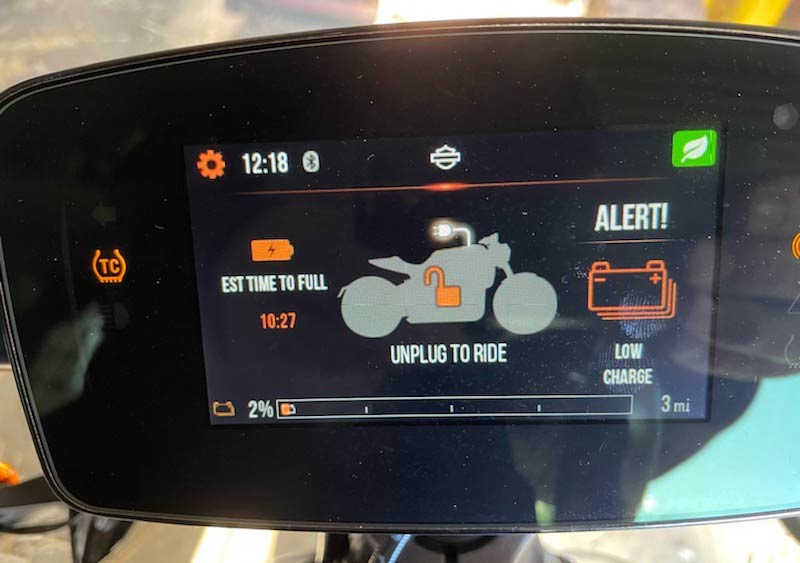
Now I don’t doubt that electric bikes will be part of our future. I suspect they’ll probably be the saviour of dirt bike riding actually, with the absence of noise allowing dirt bike parks near built up areas. The Livewire is ok, in and of itself. It goes well enough. But range continues to be a serious road block and it turns out that you won’t always get the claimed minimum. It quite literally falls short.
One ride into Torquay for lunch and back on sport mode (36 km return, less than 40 mins riding in total), sucked 40 per cent of the juice which equated to a five-hour recharge to full.
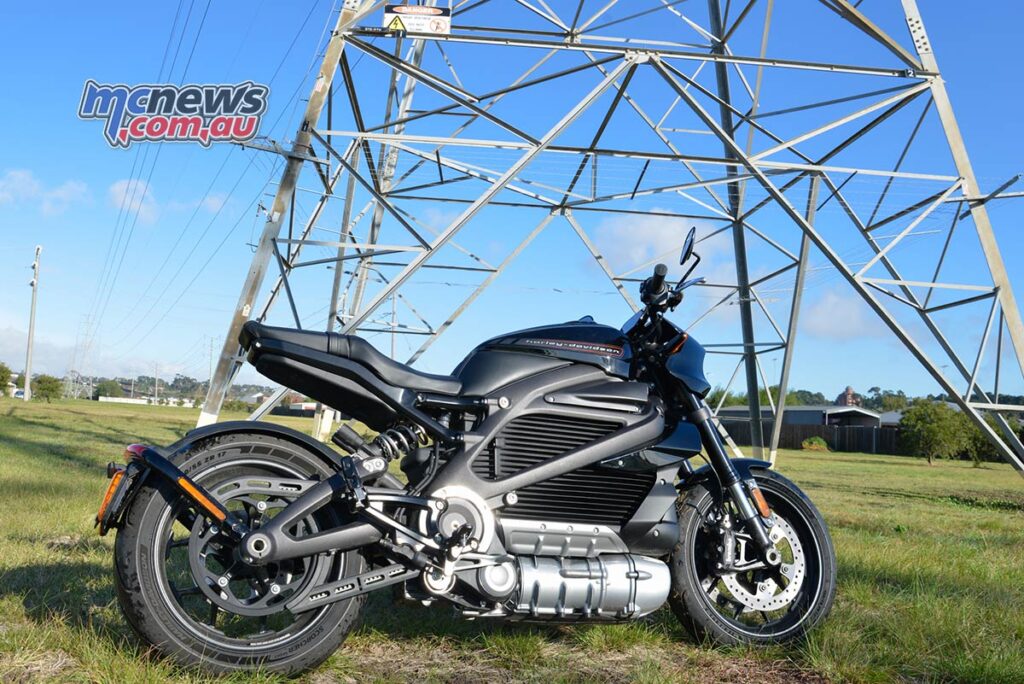
So! Who’s it for? Well. I’d be hesitant to plan any weekend rides longer than 100 kilometres based on what I’ve seen, so that’s somewhat limiting. Sure, long trips can be done if you plan them out according to charging stations and are willing to wait at least 40 minutes once you get access to that quick charger. But are the charging stations where we actually want to ride? Well no.. they mostly aren’t. Not yet. Not for me anyway.
So that leaves it to folks living in town (which should also extend that safe minimum range a little further), who might be commuting less than 60 km to work and then home where they can whack it on charge overnight. Those who might like a quick little run over to a mates house, or to pop down to their favourite cafe for a coffee and some smashed avo. And those people have to be willing to drop 50 big ones on a bike with said limitations. If that’s you, and you’re an early adopter type person – definitely check it out. Certainly the performance of the motor shows the potential of things to come.
For me personally, I’d need the range to be at least double what it currently is. I can’t even get to my office from home (110 km), let alone there and back…
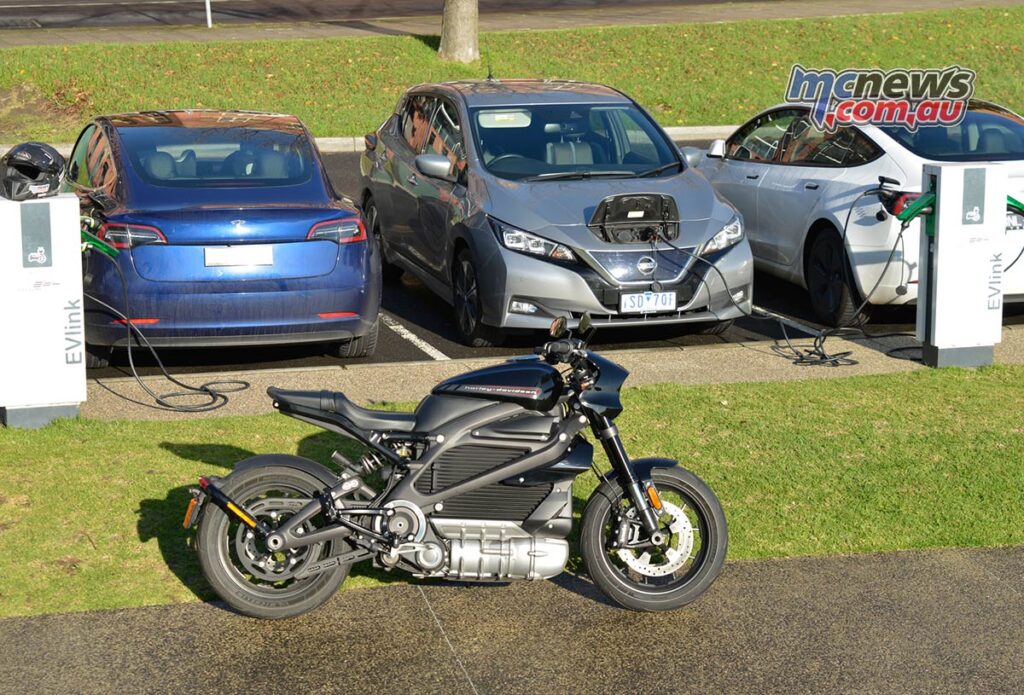
Harley-Davidson LiveWire
Why I like it
- On road performance is more than adequate, it goes bloody well
- Incredibly linear power delivery is remarkable
- Nice enough manners around town, easy to ride.
- Turns out it makes a pretty mad burnout machine if that’s your thing!
I’d like it even more if…
- Being able to charge the system when flat might be a nice touch… At the very least, if it’s a known limitation, put an easily accessible charge plug for the secondary 12v battery.
- Range is a show stopper. Literally. <110kms from full for me on a mix of urban and highway!
- Steering and suspension unnecessarily firm – would benefit from being more accommodating
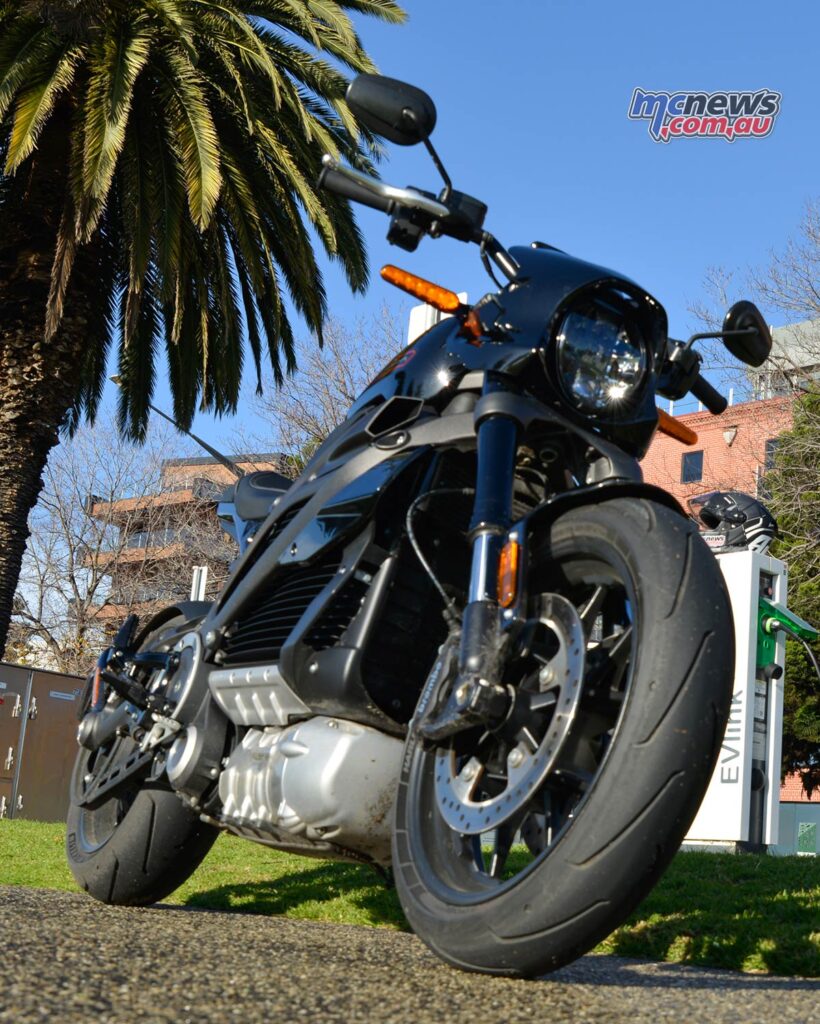
Harley-Davidson LiveWire Specifications
|
SPECIFICATIONS |
|
|
EV SPECIFIC CONTENT: MOTOR |
|
|
Torque |
86 ft-lb |
| RPM max | 15,000 |
| Type | Internal Permanent Magnet Synchronous Motor with Water Jacket cooling |
| Motor Name | Revelation® |
| Inverter type | IGBT |
| Pole Count | 6 |
| Power (hp/kW) | 105 HP (78kW) |
| Diameter | 6.69 in. (170 mm) |
| Stack Length | 3.94 in. (100 mm) |
|
EV SPECIFIC CONTENT: RESS |
|
|
Type |
Lithium Ion |
| Capacity | 15.5kWh total, 13.6kWh min usable |
|
EV SPECIFIC CONTENT: Charging |
|
|
Charge Plug Type |
SAE J1772 Combo Inlet (CCS1) / IEC 62196 Combo Inlet (CCS2) |
| On-board charger, charge rate | 1400 W |
| AC wall charging time (not verified) | Target – Full charge in 12.5 hrs |
| – Capable of 12.6 miles/hour charge rate (MIC city cycle) | |
| DC fast charging time (not verified) | Target – Full charge in 1.0 hr |
| – Capable of 192 miles/hour charge rate (MIC city cycle) | |
| DC to DC conversion | 450W at 14.2V |
|
EV SPECIFIC CONTENT: Range |
|
|
MIC City |
146 mi (235 km) |
| Highway (70 mph sustained) | 70 mi (113 km) |
| Combined | 95 mi (152 km) |
| WMTC (World Motorcycle Test Cycle) | 98 mi (158 km) |
|
INFOTAINMENT |
|
|
Hands-free Mobile Phone – via Bluetooth |
Standard |
| Voice Recognition Languages: Phone functions only | Via paired iOS or Android device |
| Voice Recognition Languages: Tuner/Media/ Navigation | Via paired iOS or Android device |
| USB | USB Type-C |
| Bluetooth | Phone/media supported |
| Telematics | Standard |
|
DIMENSIONS |
|
|
Length |
84.1 in. (2,135 mm) |
| Overall Width | 32.7 in. (830 mm) |
| Overall Height | 42.5 in. (1,080 mm) |
| Seat Height, Laden / Unladen | 30 in. (761 mm) / 30.7 in. (780 mm) |
| Ground Clearance | 5.1 in. (130 mm) |
| Rake (steering head) | 24.5 deg |
| Trail | 4.3 in. (108 mm) |
| Wheelbase | 58.7 in. (1,490 mm) |
| Tires, Type | Michelin® Scorcher® “Sport” |
| Tires | Scorcher® “Sport” |
| Tires, Front Specification | 120/70 ZR17 58W |
| Tires, Rear Specification | 180/55 ZR17 73W |
| Transmission Capacity | 0.34 qt (0.32 L) |
| Coolant Capacity | 0.8 qt. (0.72 L) |
| Weight, As Shipped | 549 lb. (249 kg) |
| Weight, In Running Order | 549 lb. (249 kg) |
| Gross Vehicle Weight Rating | 949 lb. (430 kg) |
| Gross Axle Weight Rating, Front | 434 lb. (197 kg) |
| Gross Axle Weight Rating, Rear | 580 lb. (263 kg) |
|
DRIVETRAIN |
|
|
Primary Drive (*Cert) |
Spiral bevel gear , 55/17 ratio |
| Final Drive (*Cert) | Belt, 3/1 ratio |
| Transmission | Single Speed |
| Gear Ratios (overall) 1st (*Cert) (X.XXX) | 10 |
|
Frame |
Aluminum cast |
| Swingarm | Aluminum cast |
| Front Fork | SHOWA 43 mm Inverted Separate Function Forks – Big Piston (SFF-BP®), fully adjustable |
| Rear Shocks | SHOWA Balance Free Rear Cushion Lite (BFRC-lite®), fully adjustable |
| Wheels, Type | Black, Split 5-Spoke Cast Aluminum |
| Wheels, Front Dia. / Width | 17 in. (432 mm) / 3.5 in. (89 mm) |
| Wheels, Rear Dia. / Width | 17 in. (432 mm) / 5.5 in. (140 mm) |
| Brakes, Caliper Type | Dual 4-piston monoblock radial mount front, dual-piston rear |
| Brakes, Rotor Type | Dual floating rotors (front), floating rotor (rear) |
| Brakes, Front Diameter / Thickness | 11.8 in. (300 mm) / 0.2 in. (5 mm) |
| Brakes, Rear Diameter / Thickness | 10.2 in. (260 mm) / 0.2 in. (5 mm) |
| Brakes, Anti-Lock Braking System (ABS) | Standard |
| Suspension Travel, Front / Rear | 4.5 in. (115 mm) / 4.5 in. (115 mm) |
|
PERFORMANCE |
|
|
Lean Angle Testing Method |
J1168 |
| Lean Angle, Right / Left (deg) | 45 / 45 |
|
Battery |
Lithium Ion, 12.8V , 24 Wh, 120 A |
| Charging | Onboard DC to DC conversion |
| Lights (as per country regulation), Headlamp | All LED, low beam, high beam and signature position lamp |
| Lights (as per country regulation), Tail/Stop | LED with light pipe tail |
| Lights (as per country regulation), Front Signal Lights | LED |
| Lights (as per country regulation), Indicator Lamps | High beam, turn signals, ABS, traction control, EV fault |
| Lights, Rear Turn Signals | LED, Amber |
| Gauges | 4.3” WQVGA 480×272 TFT Color Display with Ambient Light Sensor, 9 warning lights, Real Time Clock and Integrated Bluetooth Connectivity to a Smartphone to provide infotainment features including turn-by-turn navigation, telephone, music, and voice recogni |
| Electric Power Outlet | USB C-type; output 5V at 3A |
| Price | $49,995 Ride Away |
Source: MCNews.com.au
